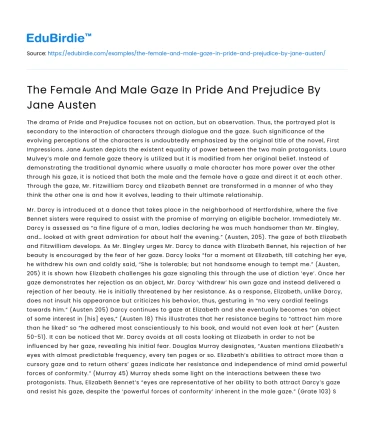The drama of Pride and Prejudice focuses not on action, but on observation. Thus, the portrayed plot is secondary to the interaction of characters through dialogue and the gaze. Such significance of the evolving perceptions of the characters is undoubtedly emphasized by the original title of the novel, First Impressions. Jane Austen depicts the existent equality of power between the two main protagonists. Laura Mulvey’s male and female gaze theory is utilized but it is modified from her original belief. Instead of demonstrating the traditional dynamic where usually a male character has more power over the other through his gaze, it is noticed that both the male and the female have a gaze and direct it at each other. Through the gaze, Mr. Fitzwilliam Darcy and Elizabeth Bennet are transformed in a manner of who they think the other one is and how it evolves, leading to their ultimate relationship.
Mr. Darcy is introduced at a dance that takes place in the neighborhood of Hertfordshire, where the five Bennet sisters were required to assist with the promise of marrying an eligible bachelor. Immediately Mr. Darcy is assessed as “a fine figure of a man, ladies declaring he was much handsomer than Mr. Bingley, and… looked at with great admiration for about half the evening.” (Austen, 205). The gaze of both Elizabeth and Fitzwilliam develops. As Mr. Bingley urges Mr. Darcy to dance with Elizabeth Bennet, his rejection of her beauty is encouraged by the fear of her gaze. Darcy looks “for a moment at Elizabeth, till catching her eye, he withdrew his own and coldly said, “She is tolerable; but not handsome enough to tempt me.” (Austen, 205) It is shown how Elizabeth challenges his gaze signaling this through the use of diction ‘eye’. Once her gaze demonstrates her rejection as an object, Mr. Darcy ‘withdrew’ his own gaze and instead delivered a rejection of her beauty. He is initially threatened by her resistance. As a response, Elizabeth, unlike Darcy, does not insult his appearance but criticizes his behavior, thus, gesturing in “no very cordial feelings towards him.” (Austen 205) Darcy continues to gaze at Elizabeth and she eventually becomes “an object of some interest in [his] eyes,” (Austen 18) This illustrates that her resistance begins to “attract him more than he liked” so “he adhered most conscientiously to his book, and would not even look at her” (Austen 50-51). It can be noticed that Mr. Darcy avoids at all costs looking at Elizabeth in order to not be influenced by her gaze, revealing his initial fear. Douglas Murray designates, “Austen mentions Elizabeth’s eyes with almost predictable frequency, every ten pages or so. Elizabeth’s abilities to attract more than a cursory gaze and to return others’ gazes indicate her resistance and independence of mind amid powerful forces of conformity.” (Murray 45) Murray sheds some light on the interactions between these two protagonists. Thus, Elizabeth Bennet’s “eyes are representative of her ability to both attract Darcy’s gaze and resist his gaze, despite the ‘powerful forces of conformity’ inherent in the male gaze.” (Grate 103) Subconsciously, it can be determined that Mr. Darcy is appreciating Elizabeth’s gaze since he later reflects on “the very great pleasure which a pair of fine eyes in the face of a pretty woman can bestow.” Because Elizabeth has ‘fine eyes’ she looks at him and interrupts his schemes.
Save your time!
We can take care of your essay
- Proper editing and formatting
- Free revision, title page, and bibliography
- Flexible prices and money-back guarantee
Eventually, Darcy begins controlling his gaze by looking without admiration and only to criticize Elizabeth. This male personae asserts his gaze only to his friends and himself to demonstrate him using his gaze to alter other character’s opinion. Mr. Darcy’s gaze serves for him to make him believe that Ms. Bennet is not attractive, rather than to accept it as true. Ultimately, he cannot withstand her resistance and tries to “detect with a critical eye” (Austen 18) but he is forced to find Elizabeth pretty and change his gaze, not able to regain his perspective of disdain. This demonstrates Elizabeth Bennet’s power as object of his gaze.
A shift of perception is denoted when Mr. Darcy feels pleasure being an object of Elizabeth’s gaze. He surrenders, “on the very great pleasure which a pair of fine eyes in the face of a pretty woman can bestow.” (Austen, 22) The syntax in this quote empowers Elizabeth while he phrases her eyes as responsible for her desirable beauty. Mr. Fitzwilliam Darcy admires Ms. Elizabeth Bennet’s refusal to surrender to his gaze, thus, he sees it mutual resistance. Elizabeth laughs at his description of her, “we neither of us perform to strangers,” (Austen 151) suggesting that due to her, once again, lack of performance to cave into his gaze, Darcy’s desire increased. At the end of the novel, when Elizabeth questions Darcy about his initial admiration for her, she remarks “my beauty you had early withstood... did you admire me for my impertinence?” Darcy responds, “for the liveliness of your mind, I did.” (Austen 327) He equates his admiration for her with her mind, not her beauty. It can be perceived how the word ‘impertinence’ defined by the Oxford English Dictionary as “not appertaining or belonging to” or “incongruous,” means how Darcy has incorporated Elizabeth's perspective.






 Stuck on your essay?
Stuck on your essay?

